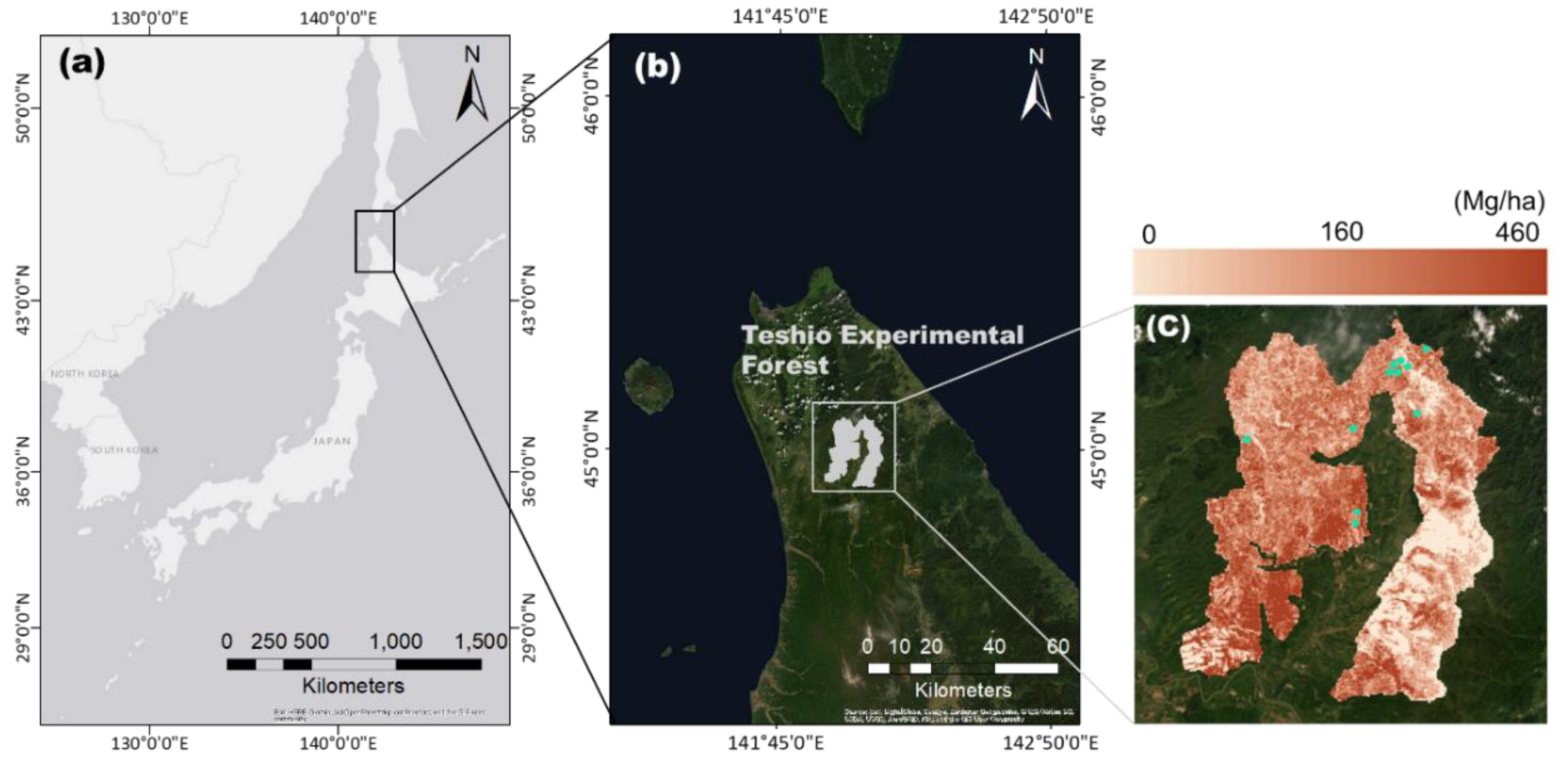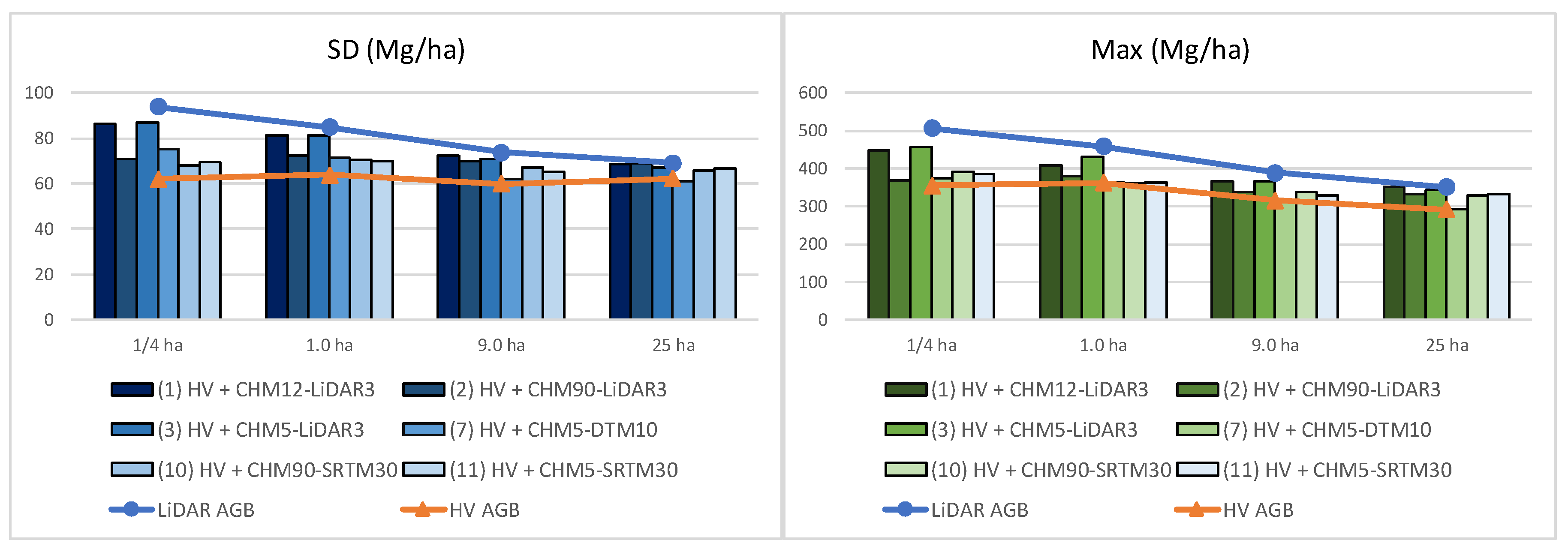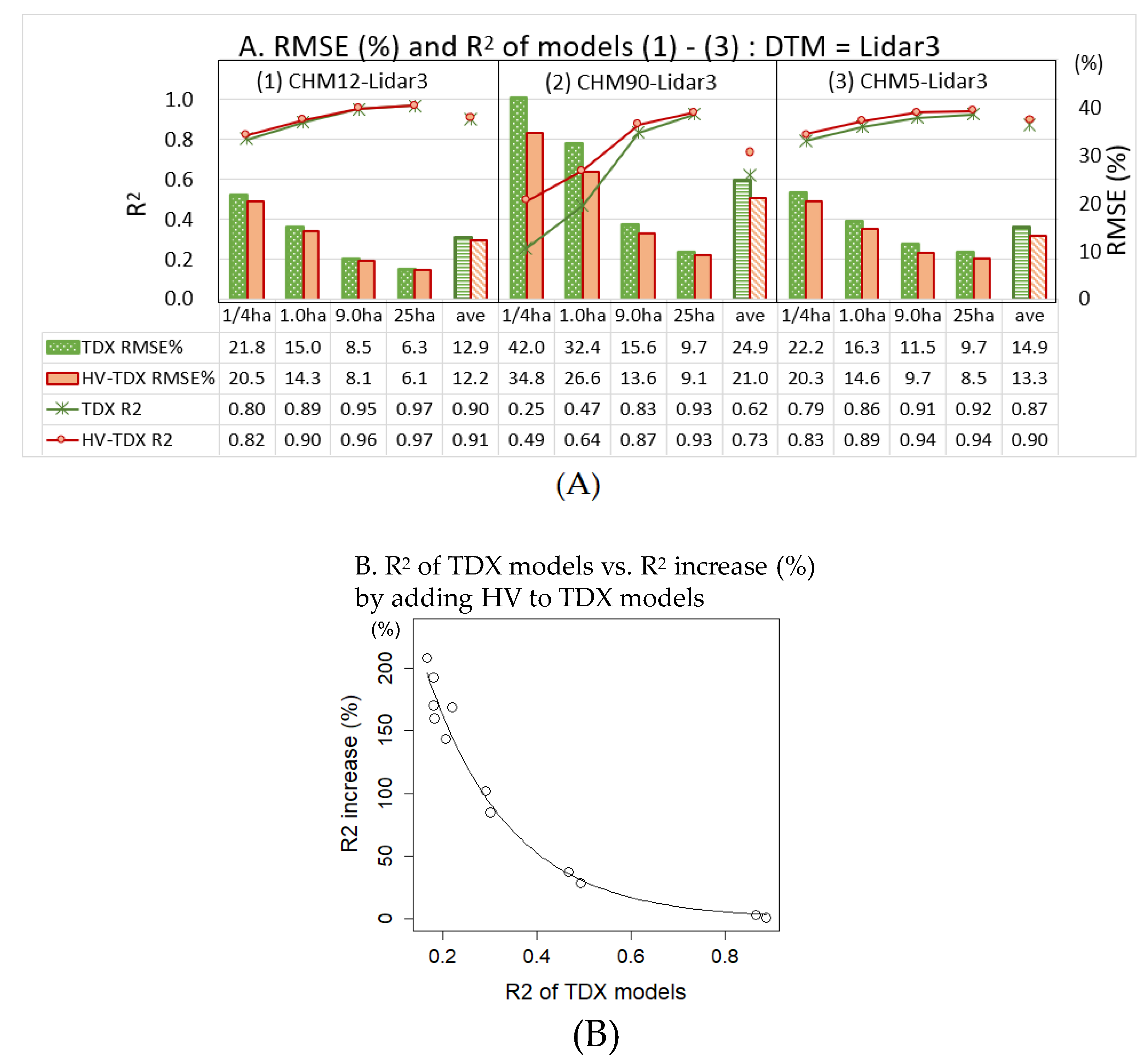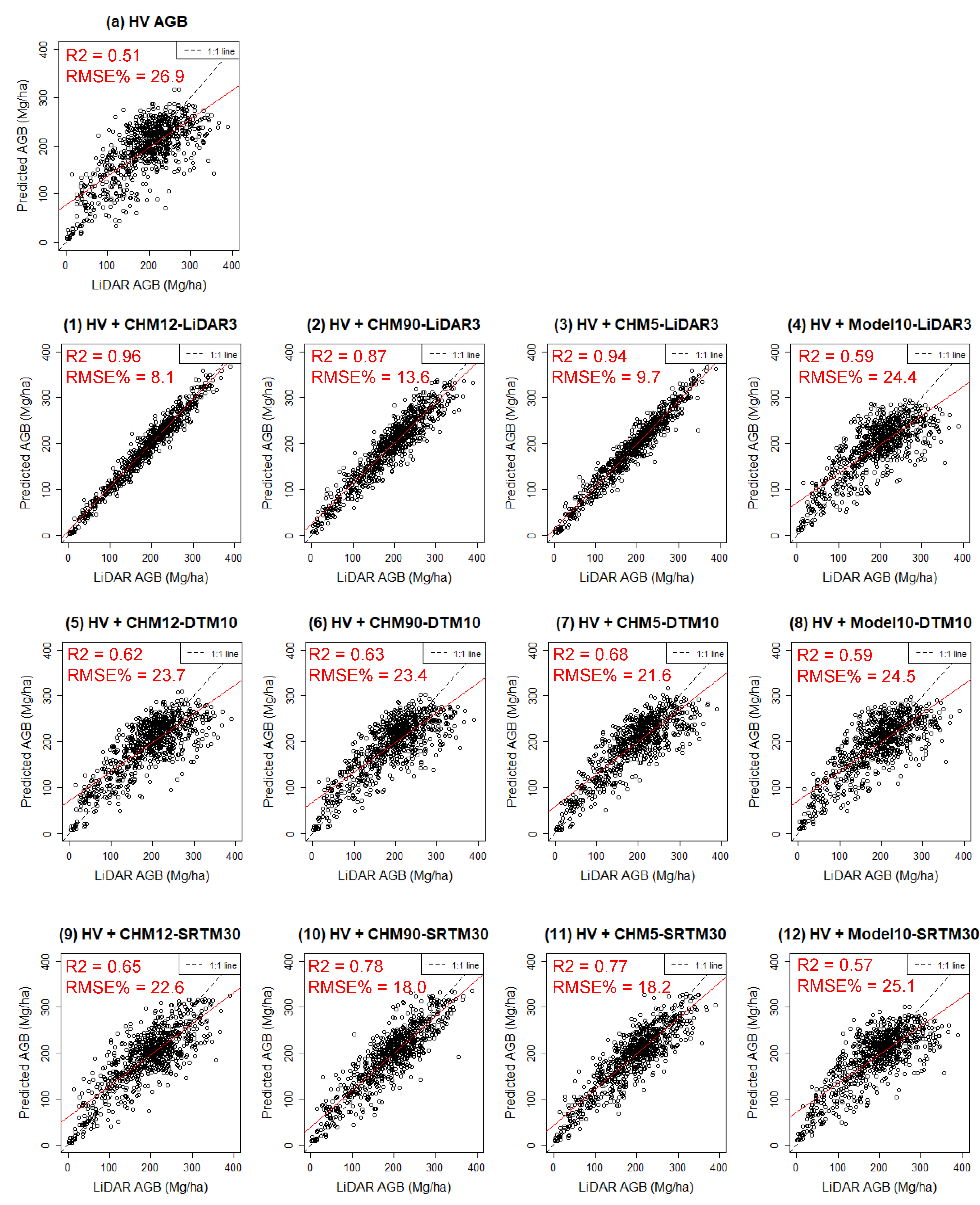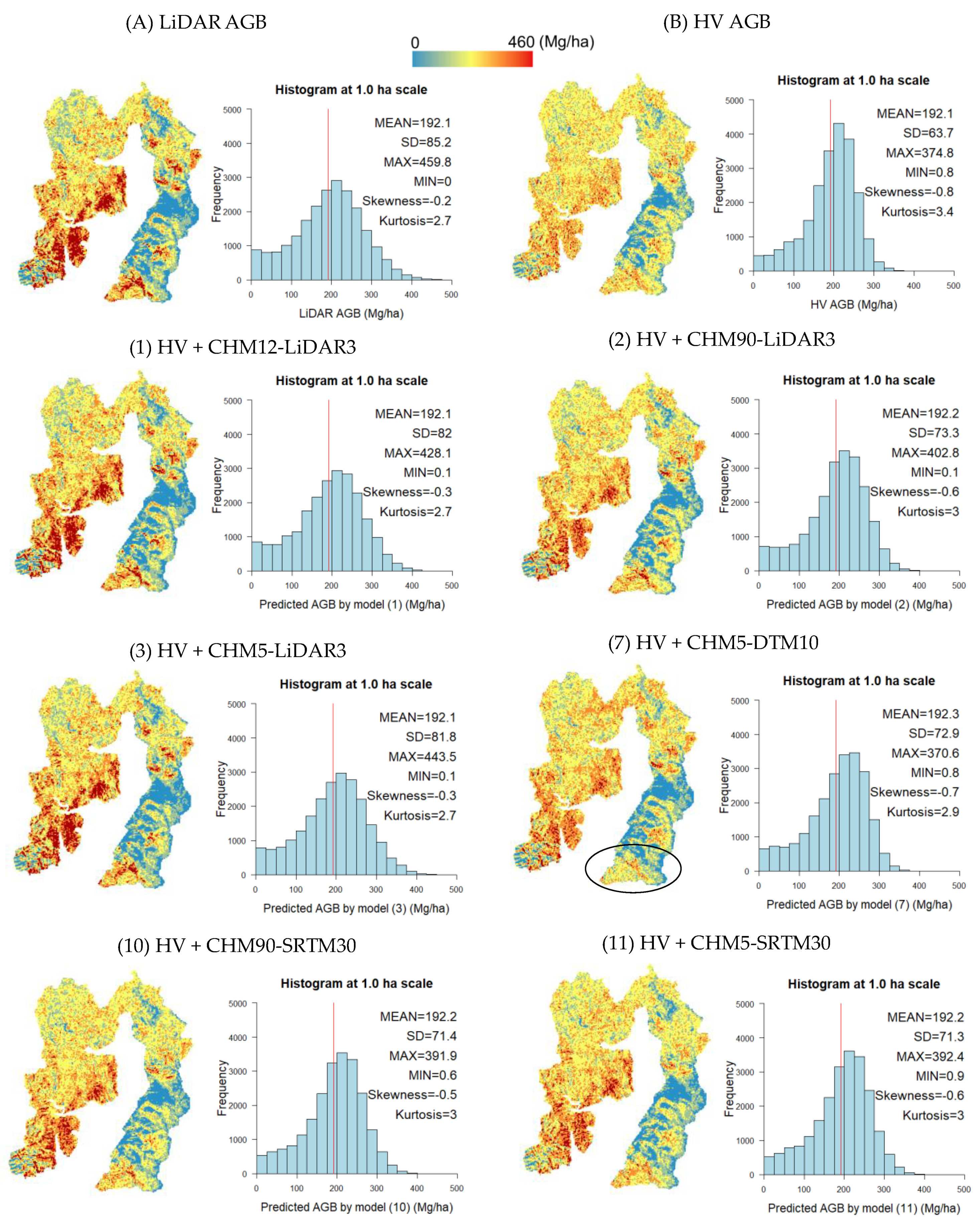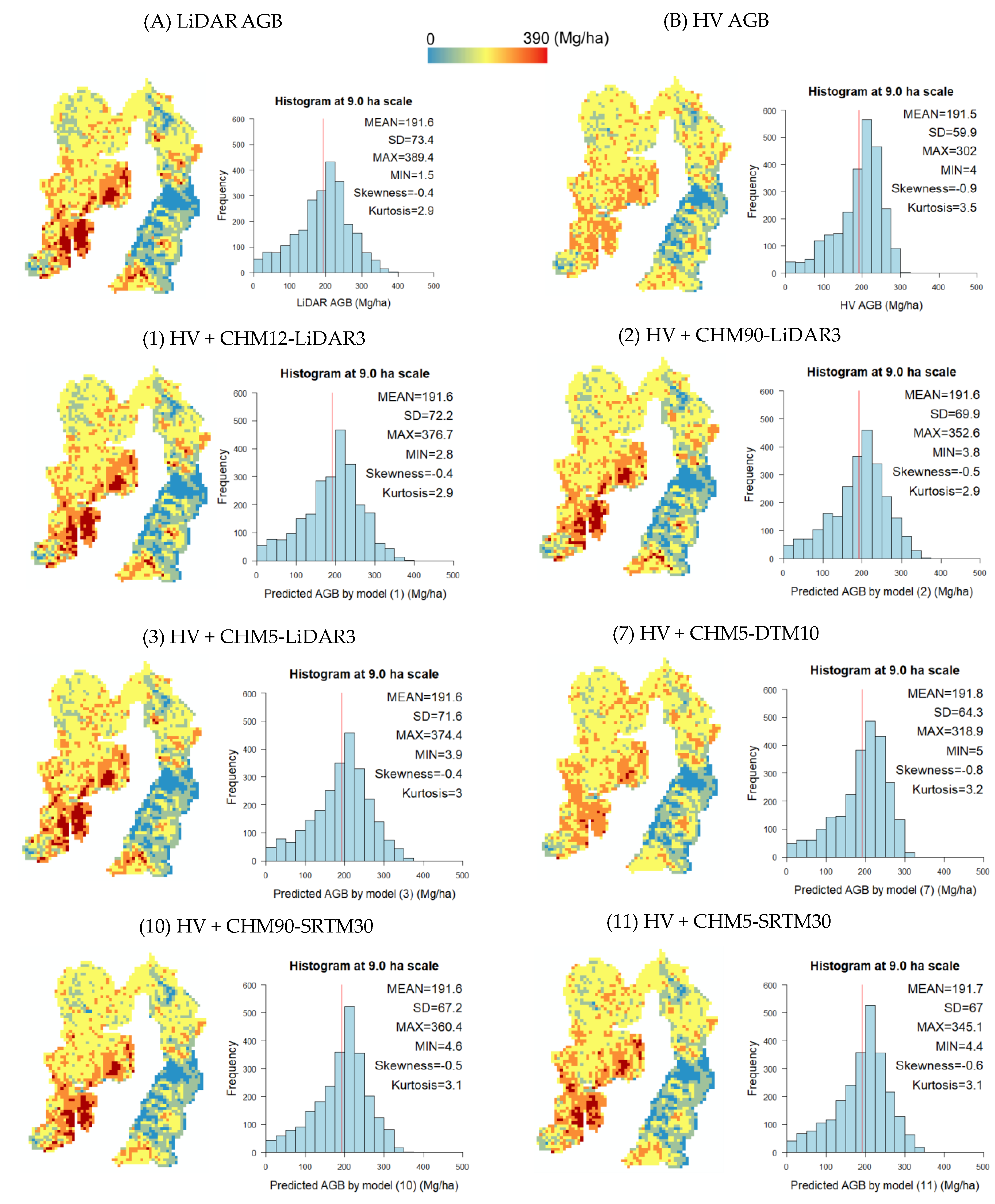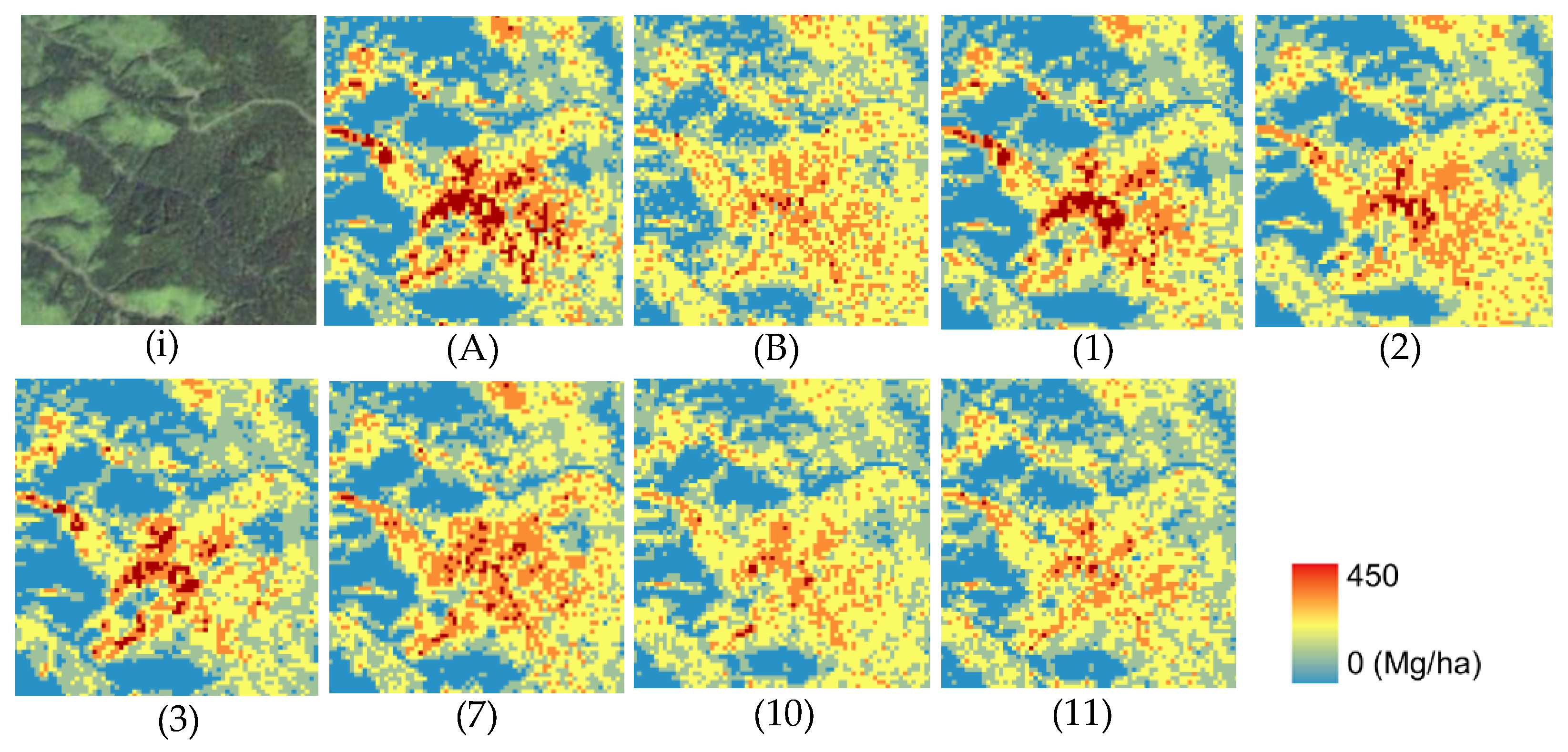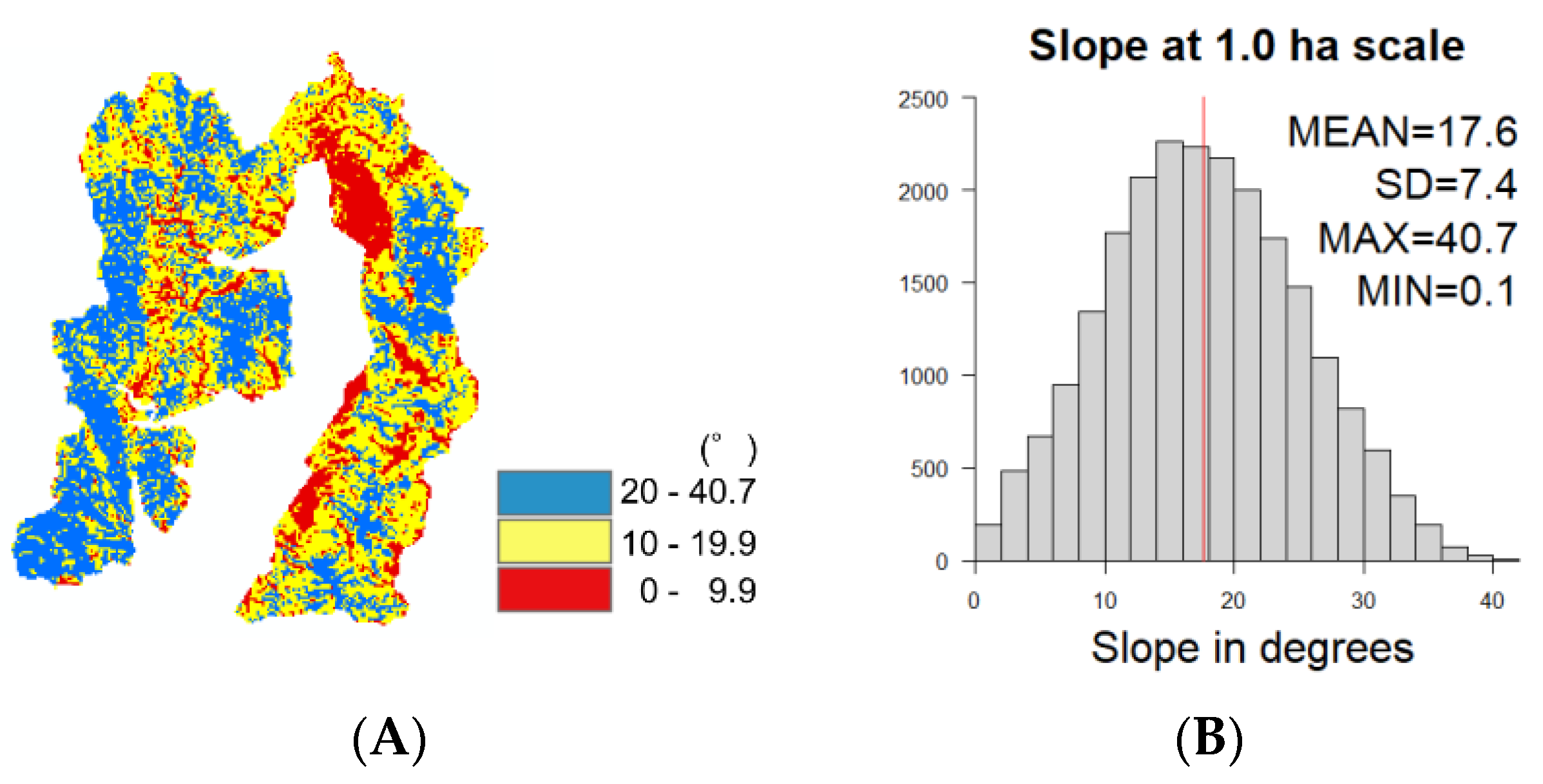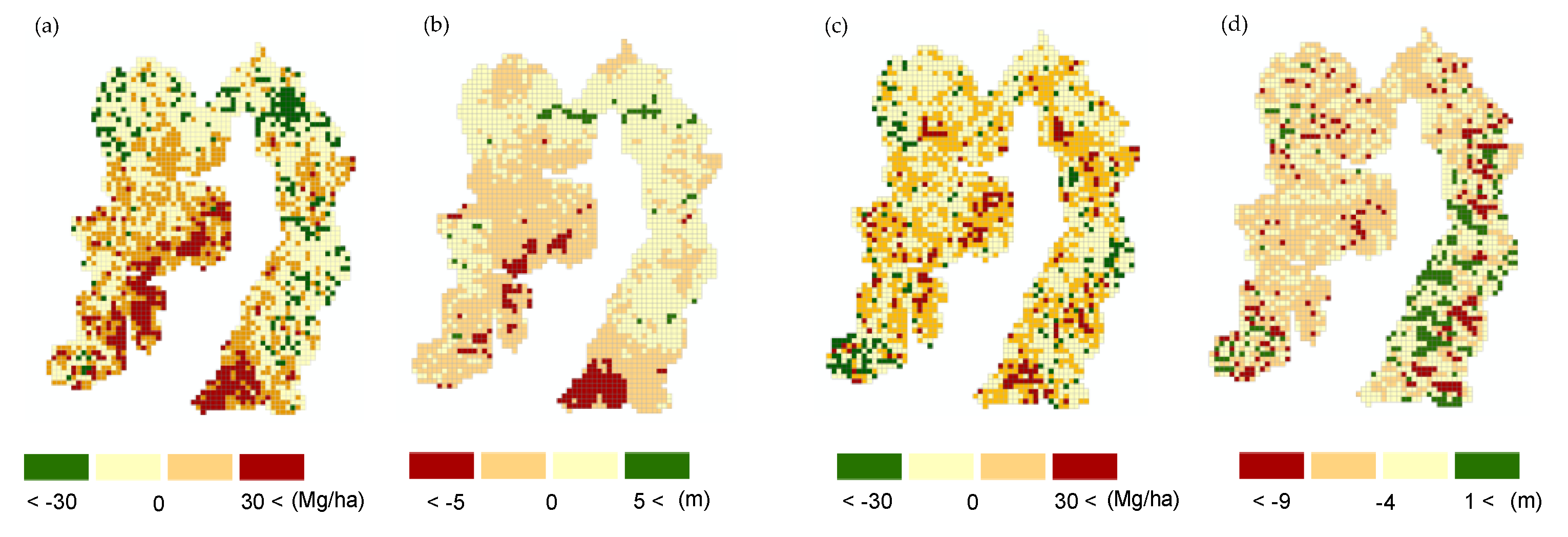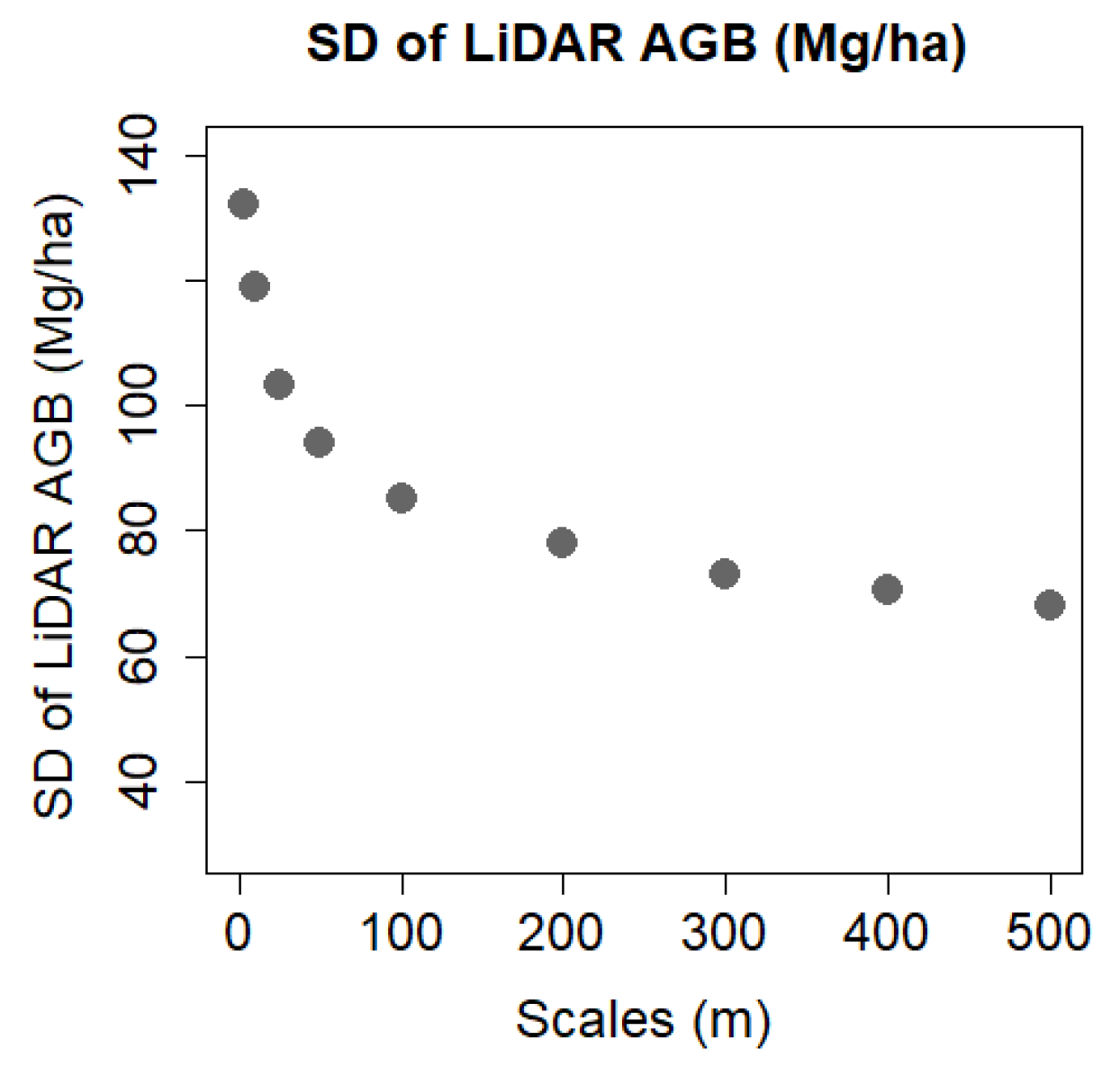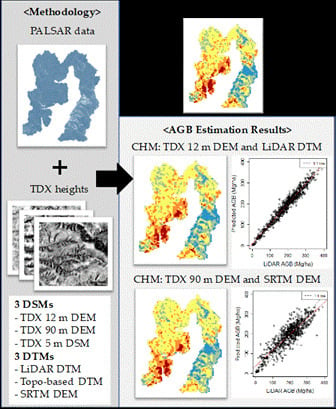1. Introduction
The accurate estimation of forest above-ground biomass (AGB) has become an imperative task for us in a time of the increasing global temperature [
1], as it directly relates to the carbon amounts stored in terrestrial ecosystems [
2,
3]. Among several techniques for estimating AGB (e.g., destructive field sampling, stereo aerial photogrammetry, and airborne laser scanning (ALS) surveys), satellite-based remote sensing is expected to produce a large-scale AGB estimation map for its wide-spatial and continuous-time coverage and its increasing data availability [
4,
5]. In particular, microwave synthetic aperture radar (SAR) satellites have high potential, due to their all-weather, day and night observation capabilities and their intrinsic ability to penetrate through tree canopies [
6,
7,
8]. With biomass-focused SAR satellites awaiting launch in the coming years (e.g., ALOS-4, NISAR and BIOMASS), it is important to assess the capabilities of the currently available SAR satellites to estimate AGB in preparation for the next-generation SAR satellites.
There have been many studies on the characteristics of remote-sensing data that can be used to effectively estimate forest AGB. The most common characteristic is SAR backscatter, which shows high sensitivity to forest AGB. Longer wavelengths, such as the L-band (15–30 cm) and the P-band (30–100 cm), have a better correlation with forest AGB, as they interact with trunks and large branches, in which most of the AGB resides [
9,
10]. Currently, the P-band SAR data have been provided by airborne platforms only, such as E-SAR [
11], BIOSAR [
12] and TropiSAR [
13], and therefore, the data coverage is limited. On the other hand, the L-band SAR data have been offered by not only airborne (UAVSAR [
14]), but also spaceborne platforms, including the ALOS (the Advanced Land Observing Satellite), the ALOS-2 (the Advanced Land Observing Satellite 2) and the SMOS (the Soil Moisture and Ocean Salinity Mission). In particular, the global backscattering data of the ALOS PALSAR (the Phased-Array-Type L-Band SAR) and the ALOS-2 PALSAR-2 (the Phased-Array-Type L-band SAR-2) have been well archived annually and provided in a mosaic form by the Japan Aerospace Exploration Agency (JAXA) since 2007, with an interval of no data between 2011 and 2014, which have been widely used for remote sensing-based AGB estimation studies [
15,
16,
17,
18]. However, it is also known that the SAR radar sensitivity to forest AGB reduces at higher AGB ranges and it is difficult for the SAR radar to predict high AGB values (known as saturation); this occurs for the L-band at around 100–150 Mg/ha and for the P-band at around 200 Mg/ha [
19,
20].
To solve this saturation issue, forest vertical information (the forest height) has recently been focused on as a parameter to estimate AGB, as techniques, such as SAR interferometry (InSAR) [
21,
22], polarimetric SAR interferometry (POLInSAR) [
23,
24] and radargrammetry [
25,
26,
27], have matured. In case of SAR data, the most common technique to retrieve a forest height is InSAR [
28], in which two SAR images of the same area acquired at different times are interfered to produce maps called interferograms. The interferogram contains a phase difference of the two images, which is used to generate a digital elevation model (DEM) [
29]. The DEM represents the elevation of the Earth, which is categorized into two models of a digital surface model (DSM) and a digital terrain model (DTM); a DSM represents the elevation of the Earth’s surface, including the heights of trees, buildings and other features on the Earth, while a DTM represents the elevation of the bare Earth with these features on the Earth removed digitally. Through the InSAR process, a DSM is produced. The shorter the wavelengths of the SAR band, e.g., X-band (2.4 to 3.7 cm), the closer the elevation of the DSM to the canopy top. A DTM is also developed with several methodologies, including the InSAR, ALS and aerial photograph analysis; among them, an ALS-based DTM is the most frequently used in AGB estimation studies, due to its high quality and precision. Using the DSM and the DTM, the forest height is obtained by subtracting the DTM from the DSM and the resultant forest height is called a canopy height model (CHM). The CHM is the simplest method to obtain the forest height.
It has already been shown that the combined use of the ALOS PALSAR backscatter and an InSAR-derived CHM (a forest height) improved the estimation accuracy of forest AGB and significantly reduced the saturation issue; the combined use of ALOS PALSAR backscatter and the InSAR-derived phase-center height developed from Shuttle Radar Topography Mission (SRTM) DEM and ALS-derived DTM, and ALS-derived height indices [
15]; the combined use of ALOS PALSAR backscatter and the penetration depths obtained by the subtraction of the InSAR-derived ALOS height from the canopy top height derived from the Advanced Spaceborne Thermal Emission and Reflection Radiometer (ASTER) Global DEM (GDEM) [
30]. This combined use of multiple datasets is called a data synergy or fusion approach, which integrates data from different sources to obtain the target information with better accuracy. This approach has also been used for a variety of remote sensing datasets to enhance the AGB estimation accuracies; e.g., the combined use of ALOS PALSAR backscatter, Satellite Pour l’Observation de la Terre (SPOT)-5 vegetation indices and ALS-derived height [
16], the combined use of spaceborne Light Detection and Ranging (LiDAR) and airborne LiDAR [
31], the combined use of airborne LiDAR and Landsat Enhanced Thematic Mapper Plus (ETM+) data [
32], and the combined use of airborne LiDAR and digital stereo imagery [
33]
TanDEM-X (TDX) is a SAR satellite launched as a TerraSAR-X (TSX) add-on in June 2010 by the German Aerospace Center (DLR). It is the only single-pass spaceborne SAR interferometer currently available [
34,
35], after SRTM. With its outstanding feature of a single-pass bistatic mode, the TDX provides simultaneous InSAR data without negative influence from temporal decorrelation. This ensures the development of a DEM of higher precision, compared to a DEM produced by widely used repeat-pass satellites (e.g., Sentinel-1A and 1B). Besides providing high-quality TDX–TSX image pairs by scenes or tiles, its primary mission is to generate a global high-precision DEM product with 12 m horizontal resolution [
36]. Now, the mission has been accomplished and the TDX DEM product is provided with the nominal pixel spacing of 0.4 arcsecond (12 m), and a larger pixel spacing of 1 arcsecond (30 m), and 3 arcseconds (90 m) [
37,
38]. As the TDX DEM represents a DSM, we hereinafter refer to it as TDX DSM. The TDX DSM is a global product derived from multiple TDX acquisitions. The TDX 12 m DSM has the absolute horizontal and vertical accuracy of 2 m and the relative vertical accuracy of 2 m to 4 m [
37], and its high accuracy has also been demonstrated in studies [
39,
40,
41]. The products with larger pixel spacing have an improved relative vertical accuracy at the expense of detail, and the TDX 90 m DSM covers all of the Earth’s landmasses from pole to pole [
37]. So far, a good correlation between forest AGB and the TDX CHM derived from the TDX DSM and an ALS-based DTM have been reported in boreal or less dense forest environments [
42,
43,
44,
45]. Also, a good correlation between forest AGB and TDX-derived phase height time series or TDX-derived InSAR coherence have been reported in dense forest environments [
46,
47]. Thus, the TDX DSM has a high potential to yield high-accuracy AGB estimates.
When creating a CHM, the use of a high-quality DTM is also inevitable, as it determines the accuracy of the AGB estimates. Although an ALS-based DTM is frequently used for AGB estimation studies, in reality a topography-based DTM still remains the only choice for AGB estimation in most countries, due to the high cost and small survey area of the ALS. Karila et al. [
42] said that, regarding the wide-area AGB mapping, the main obstacle is the availability of ALS-based terrain models. Although the area coverage of the ALS survey has increased at a country level (e.g., Finland [
44], Norway [
45], U.S. [
15]), it is still small. Therefore, it is also important to test not only the high-quality ALS-based DTM, but also the topography-based and other possible DTMs for AGB estimation and compare the AGB estimation results derived from these different types of DTMs, and find the best DTM for the areas where an ALS-based DTM is not available. It is also important to analyze the data scales and topographic features necessary to improve the AGB estimation accuracies for them. As one of the possible DTMs, the near-global C-band SRTM DEM has the potential to serve as a DTM. It is known that the SRTM DEM serves as a DTM for most of the Earth’s surface, except for the areas with extensive tree and/or shrub coverage, e.g., the boreal and Amazon regions [
48], and that, compared to the X-band, the scattering phase center of C-band is deeper within the canopy and, therefore, relatively closer to the terrain surface [
49]. However, it is also known that the penetration of the C-band SAR signal through the canopy depends on the height and density of the forest [
49]. It indicates the possibility of the SRTM DEM to serve as a DTM in less dense forested areas. Our test site is located in a hemi-boreal zone with medium forest cover. Although most studies have treated the SRTM DEM as a DSM [
50,
51,
52], it is necessary to examine the possibility for the SRTM DEM to serve as a DTM in the hemi-boreal region. If the SRTM DEM was found to serve as a DTM in our test site, it enhances the opportunity of producing a large-scale AGB map with a global TDX DSM.
To obtain a forest height, model-based schemes have also been proposed [
53]. One of the characteristics of the model-based approach lies in its sophisticated modeling, which can improve the accuracy of the forest height estimates with the use of POLInSAR data. The most frequently used model is the Random Volume over Ground (RVoG) model [
54,
55], in which the decorrelation induced by the volume scattering in the interferometric coherence and the physical properties of the forest layers are related [
56]. However, the RVoG model, which can itself be considered as a simplified version of the Interferometric Water Cloud Model (IWCM) [
53,
57,
58,
59], is still too complicated, and simpler models have been developed for practical use [
56]. The Sinc inversion model is one of them; it assumes that the relationship between canopy height and the volumetric coherence amplitude follows a Sinc function [
56,
60,
61,
62]. The Sinc inversion model employs a simple methodology and retrieves forest properties well using TDX–TSX image pairs [
60]. However, there are still few studies. The accumulation of studies using the Sinc inversion model and comparisons of their outcomes to those derived from the non Sinc inversion model-based approach is necessary. The forest height derived from the Sinc inversion model is referred to as ModelH in this study.
With its capability to provide a high-precision DSM, TDX has become a platform which is highly suitable for forest AGB estimation. So far, the combined use of ALOS PALSAR backscatter and forest heights derived from several platforms including ALOS [
30] and SRTM [
15] were tested for AGB estimation (see above), there have as yet been no studies to examine if the combined use of the ALOS PALSAR backscatter and the TDX-derived forest heights can produce accurate AGB estimation results, compared to the single use of either the ALOS PALSAR backscatter or the TDX-derived forest height. As a TDX-derived forest height, two forest height creation methods of CHM and ModelH (Sinc inversion model-based forest height) should also be compared. In addition, the global product of TDX DSM has a high potential to yield high-accuracy AGB estimates, but there are still few studies examining if this ready-made DSM is suitable for AGB estimation in practice and if it is capable of producing accurate AGB estimations. If it is shown to be capable of this, a large-area AGB mapping using the global TDX DSM will become highly promising.
In this study, therefore, with an ultimate objective of finding the best AGB estimation method in our test site of the hemi-boreal region, we first developed the forest heights in the form of CHM and ModelH with varied combinations of multiple TDX DSMs and DTMs, and then integrated each of them with the ALOS PALSAR backscatter data to estimate AGB. The accuracies of the AGB estimation derived from each of them were compared to find the best AGB estimation method in our test site. As the forest heights, nine CHMs and three ModelHs were developed in total. To obtain the nine CHMs, we used three DSMs of (I) TDX 12 m DSM product, (II) TDX 90 m DSM product, and (III) TDX 5 m DSM, which we developed from two TDX–TSX image pairs for reference. The TDX DSM at 30 m resolution was not used in this study, as it had no full data coverage of our test site. As for DTMs, (i) the ALS-based DTM, (ii) the topography-based DTM and (iii) the C-band SRTM DEM were used. Each of the three DTMs of (i), (ii) and (iii) were subtracted from the three DSMs of (I), (II) and (III) to obtain the nine CHMs. Three ModelHs were also developed from the two TDX–TSX image pairs used in (III) and the three DTMs of (i), (ii) and (iii) with the Sinc inversion model (see
Section 3.3.3 for details). The TDX 12 m DSM and the two TDX–TSX image pairs were provided by DLR [
63] and the TDX 90 m DSM was downloaded from EOC Geoservice [
64].
To model AGB, a nonparametric random forest algorithm was applied, and the AGB estimation results derived from combining the ALOS PALSAR backscatter and each of the nine CHMs and three ModelHs were compared against LiDAR-derived AGB. The LiDAR-derived AGB was used as reference AGB throughout this study. Four data scales of 1/4 ha (50 m × 50 m), 1.0 ha (100 m × 100 m), 9.0 ha (300 m × 300 m) and 25 ha (500 m × 500 m) were used to derive the AGB estimations and to investigate the scale effects on the AGB estimation. The 1.0 and 9.0 ha scales were used as focal scales in this study, as they represent the average size of forest stands (2.6 to 15 ha), the minimum unit for forest management in Japan (see
Section 5.6 for more details). A test site was chosen in a hilly area in a hemi-boreal region of northern Hokkaido, Japan. Taking into consideration the effects of the varying slopes on the AGB estimation, a slope-class analysis was also conducted.
This study especially aimed to (1) evaluate the data synergy effects of integrating the ALOS PALSAR backscatter and each of the nine CHMs and three ModelHs on the AGB estimation; (2) evaluate the ability of the two TDX DSM products (TDX 12 m DSM and TDX 90 m DSM) to estimate AGB in practice in the hemi-boreal region by comparing the AGB estimated by them against those estimated by the TDX 5 m DSM, which we developed for reference; (3) examine how the different forest height creation methods (the DSM and DTM subtraction for the nine CHMs and the Sinc inversion model-based approach for the three ModelHs) and the different spatial resolutions (three DSMs and three DTMs) affected the AGB estimation results.
4. Results
4.1. TDX Height Images
Figure 2 shows the closeup of our test site in (i) Landsat-7 ETM+ image and four TDX heights. The four TDX heights are all at 3 m resolution. In
Figure 2(i), the light green color indicates grassland area, while the dark green shows forested area. In
Figure 2(1)–(4), the grassland area is shown in the white color with the height of 0 m, while the forested area is shown in the black with the heights up to 30 m. The images of (1) CHM12-LiDAR3 and (3) CHM5-LiDAR3 reflect the forest height gradient from 0 to 30 m very well, while the image of (2) CHM90-LiDAR3 shows stronger color contrast in white (lower heights) and black (higher heights). The image of (4) Model10-LiDAR3 shows less black color (higher heights) than the other three images, but reflects the forest height gradient relatively well.
4.2. Effects of Adding 12 TDX Heights to HV Model
The data synergy effects of adding each of the 12 TDX heights to the HV backscatter were evaluated in terms of the R
2 increase and the RMSE decrease over the HV model (
Figure 3). In the 12 HV-TDX models, the mean LiDAR AGB values prescribed to each cell of the 1/4, 1.0, 9.0 and 25 ha scale layers (90,000, 22,500, 2500 and 900 cells, respectively) were used as a response variable and the mean values of the HV backscatter and each of the 12 TDX heights prescribed to each cell of the same layers were used as predictors to derive the R
2 and RMSE values from OOB samples.
Compared to the HV model (
Figure 3: blue line for R
2 and blue bar for RMSE), all the 12 HV-TDX models yielded higher R
2 (
Figure 3: red line) and lower RMSE (
Figure 3: red bar) across the scales. It shows a simple fact that adding any of the 12 TDX heights to the HV model improved the entire model performance. Seen by the DTM groups (LiDAR3 models, DTM10 models and SRTM30 models), the models in the same DTM group showed similar trends of R
2 values; for all the DTM10 models, the R
2 values leveled off at the 9.0 ha scale, while for all the SRTM30 models except the model (12), the R
2 values jumped at the 9.0 ha scale; the LiDAR3 models of (1) and (3) showed almost the same R
2 values across the scales.
Now, the top six models were ranked based on the average R2 values over four scales, which were in the following order: (1) HV + CHM12-LiDAR3 (R2 = 0.91) > (3) HV + CHM5-LiDAR3 (R2 = 0.90) > (2) HV + CHM90-LiDAR3 (R2 = 0.73) > (10) HV + CHM90-SRTM30 (R2 = 0.66) and (11) HV + CHM5-SRTM30 (R2 = 0.66) > (7) HV + CHM5-DTM10 (R2 = 0.64). The models (10) and (11) showed the same average R2 values. The top six models consisted of the three LiDAR3 models, two SRTM30 models and one DTM10 model. The best model (1) HV + CHM12-LiDAR3 and the 2nd best model (3) HV + CHM5-LiDAR3 both generated very high R2 > 0.82 and R2 > 0.83, respectively, across the scales. The R2 of the model (1) ranged from 0.82 to 0.97 and the largest R2 increase of the model (1) was achieved at the 1/4 ha scale from 0.20 to 0.82, or by 306%. The R2 of the model (3) ranged from 0.83 to 0.94 and the largest R2 increase of the model (3) was also achieved at the 1/4 ha scale, from 0.20 to 0.83, or by 307%. The model (1) HV + CHM12-LiDAR3 slightly outperformed the model (3) HV + CHM5-LiDAR3 which we developed for reference, indicating the high capability of the TDX 12 m DSM to yield high accuracy AGB estimates.
On the other hand, the 3rd and the two 4th best models, (2) HV + CHM90-LiDAR3, (10) HV + CHM90-SRTM30 and (11) HV + CHM5-SRTM30, started with low R2 values at the 1/4 ha scale, but at 9.0 ha the R2 jumped to 0.87, 0.78 and 0.77, respectively. Compared to the model (3) HV + CHM5-LiDAR3 which we developed for reference, the model (2) performed less well, especially at smaller scales, indicating that the TDX 90 m DSM was not able to produce AGB estimates as high an accuracy as the TDX 5 m DSM. On the other hand, the model (10) shows the R2 values almost equivalent to those of the model (11) across the scales which we developed for reference, indicating that the TDX 90 m DSM was capable of delivering AGB estimation accuracy equivalent to that of TDX 5 m DSM, when SRTM30 was used as DTM.
In contrast, the 6th best model (7) HV + CHM5-DTM10 started with an R2 of 0.57, which was higher than any other models at the 1/4 ha scale except for the LiDAR3 models of (1) and (3), but gave only a minor R2 increase afterwards; the R2 merely increased up to 0.68 at the 25 ha scale. The model (7) is a reference model for the models (5) HV + CHM12-DTM10 and (6) HV + CHM90-DTM10. This indicates that both TDX 12 m DSM and TDX 90 m DSM failed to produce AGB estimation accuracies as high as the reference model (7), when the DTM10 was used as DTM.
The bottom 3 models were the three ModelHs; (4) HV + Model10-LiDAR3, (8) HV + Model10-DTM10 and (12) HV + Model10-SRTM30. The R2 values of these 3 models were quite similar; on the average of the four scales, they were 0.52, 0.52 and 0.50, respectively. This indicates that the model performance of the 3 ModelHs were not influenced by the DTM used.
With the LiDAR AGB as a reference AGB, we also derived the SD and max values of the AGB estimates by the top 6 models over the test site, to see if the top 6 models were able to reproduce the spatial variability of the AGB properly. In this analysis, the SD and max values were used to represent the spatial variability of the AGB. First of all, by adding each of the six TDX heights (
Figure 4: blue bars for SD and green bars for Max and
Table 5) to the HV model (
Figure 4: orange line for SD and Max and
Table 5), the SD and max values became closer to those of the LiDAR AGB (
Figure 4: blue line for SD and Max and
Table 5) across the scales. This indicates that the six HV-TDX models better reproduced the spatial variability of the LiDAR AGB than the HV model. However, looking closer at the SD values at each scale, the SD values of all the six models except (1) and (3) were much lower than that of the LiDAR AGB, by the range of 20% to 28% at the 1/4 ha scale (
Table 5). This large SD deviation of the models (2), (7), (10) and (11) from LiDAR AGB was reduced to the range of 15% to 18% at the 1.0 ha scale, to the range of 6% to 16% at the 9.0 ha scale and to the range of 0% to 12% at the 25 ha scale. This indicates that the four models reproduced SD more accurately at the larger scales, due to the reduced SD values of the LiDAR AGB at the same scales. It is also notable that the model (7) showed the SD value the closest to that of LiDAR AGB except (1) and (3) at 1/4 ha scale. On the other hand, the SD values of the models (1) and (3) were only slightly lower than those of the LiDAR AGB (8% and 7% at 1/4 ha, 4% and 4% at 1.0 ha, 2% and 4% at 9.0 ha, and 0% and 2% at 25 ha scales, for (1) and (3), respectively). The results indicate that the models (1) and (3) reproduced the spatial variability very well across the scales, while the other four models require larger scales, at least the 1.0 ha scale, to reproduce the spatial variability properly (see
Section 5.6 for more details). The max values showed almost the same trend as the SD values, although the scale of the deviations were slightly larger for max values than for SD values for most models (
Table 5).
4.3. Effects of Adding HV Backscatter to TDX Models
In
Section 4.2, we analyzed the data synergy effects in terms of the HV model, while in this section, we analyzed them in terms of the 12 TDX models. Although the final R
2 and RMSE are the same between the two cases, as the R
2 values of the 12 TDX models varied from low to high, it allows us to analyze the data synergy effects in more detail.
Figure 5A shows the comparison between the 3 TDX models of (1), (2) and (3) (green color) and the 3 HV-TDX models of (1), (2) and (3) (red color). The two models (1) CHM12-LiDAR3 and (3) CHM5-LiDAR3 exhibited high model performance across the scales, with R
2 values of > 0.80 and > 0.79, respectively, and the model (2) CHM90-LiDAR3 showed high R
2 values of > 0.87 at large scales > 9.0 ha. In these three TDX models, the effect of adding the variable of HV backscatter is minute, as they predicted AGB with very high accuracies without the HV backscatter.
On the other hand, other TDX models showed low AGB estimation accuracies across the scales, with R
2 values < 0.50. This indicates that those TDX models require the HV backscatter to predict AGB with high accuracy. To analyze the data synergy effects more closely, the R
2 increases (%), which were derived from adding the HV backscatter to the 12 TDX models, were plotted against the R
2 values of the TDX models at the 1.0 ha scale (
Figure 5B). The R
2 of the HV model (HV backscatter used as a single predictor) at 1.0 ha scale was 0.35.
Figure 5B showed that the largest R
2 increase (%) was recorded by the TDX model (4) Model10-LiDAR3 from 0.17 to 0.51 (by 209%), while the smaller R
2 increase (%) was registered by (5) CHM12-DTM10 from 0.30 to 0.56 (by 85%) or by (7) CHM5-DTM10 from 0.49 to 0.63 (by 28%). It shows that the TDX models with lower R
2 values had a larger R
2 increase in relative terms, indicating that the data synergy effects were greater for the TDX models with lower model performance. The similar trend was also shown in the HV model (
Figure 3); the HV model with lower R
2 values (i.e., at 1/4 ha scale) had larger R
2 increase in relative terms, when each of the 12 TDX heights was added to the HV model. Considering that the R
2 increase was not linear but exponential (
Figure 5B), the TDX models with low R
2 values can benefit from the data synergy effects more than TDX models with high R
2 values. It indicates that the data synergy approach is better used for models with low performance to improve AGB estimation accuracies.
4.4. Scale Effect Analysis
We investigated how the spatial scales influenced the AGB estimation accuracies.
Figure 3 shows that both R
2 and RMSE improved for all the HV-TDX models as the scale grew from 1/4 to 25 ha. In particular, the models (2), (9), (10) and (11) showed a large R
2 increase and RMSE decrease at the 9.0 ha scale. The HV model (
Figure 3: blue line and blue bar), which used only HV backscatter as a predictor, also showed the same trend.
We selected the model (1) HV + CHM12-LiDAR3, the best model among the 12 HV-TDX models, to further analyze the scale effects on the AGB estimation. We made AGB difference maps on a cell-by-cell basis by subtracting the AGB values estimated by the model (1) from the LiDAR AGB at four scales from 1/4 to 25 ha (
Figure 6). The statistics of the resultant four AGB difference maps, including the mean, SD, the min and max values, were calculated to examine how the AGB difference between the LiDAR AGB and the AGB values estimated by the model (1) narrowed, as the data scale grew larger. The results show that as the scale grew larger, from 1/4 to 25 ha, the SD, the min and the max values of the AGB difference maps reduced. In particular, the SD values of the AGB difference maps reduced significantly at the 1.0 and 9.0 ha scale, from 24.1 (1/4 ha scale) to 16.1 Mg/ha (1.0 ha scale) and to 9.4 Mg/ha (9.0 ha scale). This indicates that the AGB values estimated by (1) became closer to the LiDAR AGB values at large scales > 9.0 ha. The AGB difference maps (
Figure 6) also show that the cells with large AGB difference, which were colored in blue (AGB difference < −30 Mg/ha) and red (AGB difference > 30 Mg/ha), reduced in number significantly, both for the 9.0 and the 25 ha scales. In these maps, the cells in red indicate where the LiDAR AGB (mean values prescribed to each cell) is more than 30 Mg/ha above the AGB estimated by the model (1) at the same resolution, while the cells in blue indicate where the LiDAR AGB is more than 30 Mg/ha below the AGB estimated by the model (1) at the same resolution. The cells in white indicate that there is no difference between the LiDAR AGB and the AGB estimated by the model (1) at the same resolution.
4.5. AGB Retrieval at Higher AGB Ranges
To analyze the AGB retrieval at higher AGB ranges, the AGB values estimated by the 12 HV-TDX models were compared against those of the LiDAR AGB at the 9.0 ha scale in a scatterplot (
Figure 7). We used the 9.0 ha scale as it shows the correlation between the LiDAR AGB and the predicted AGB more clearly than the 1.0 ha scale.
The (a) HV AGB showed that the fitted curve (red line) had a large deviation from the 1 to 1 line (dashed line). In addition, the AGB values were clustered between 150 and 300 Mg/ha, and the higher AGB values > 300 Mg/ha were not retrieved. It thus showed an obvious saturation. However, by adding each of the 12 TDX heights (9 CHMs and 3 ModelHs) to the HV model (
Figure 7(1)–(12)), the AGB values were distributed more evenly and the relationship between the LiDAR AGB and the estimated AGB became more linear, showing the reduced saturation issue. In particular, the three models of (1) HV + CHM12-LiDAR3, (2) HV + CHM90-LiDAR3 and (3) HV + CHM5-LiDAR3 showed very high correlations with the LiDAR AGB (R
2 = 0.96, 0.87 and 0.94, respectively). The models of (10) HV + CHM90-SRTM30 and (11) HV + CHM5-SRTM30 also showed high correlations (R
2 =0.78 and R
2 = 0.77, respectively). On the other hand, the DTM10 models (5) to (7) and the ModelHs (4), (8) and (12) failed to retrieve higher AGB values > 300 Mg/ha, although the R
2 and RMSE values improved.
4.6. Estimated TDX AGB Maps
Figure 8 and
Figure 9 show the wall-to-wall maps of (A) LiDAR AGB, (B) HV AGB and the estimated AGB by the top six models with their histograms at the 1.0 ha and 9.0 ha scales, respectively. Compared to the (B) HV AGB, all the top six HV-TDX models more accurately reproduced the spatial distribution of the (A) LiDAR AGB at both scales, as the maps and the histograms showed.
Focusing on the high AGB values > 300 Mg/ha at the 1.0 ha scale (
Figure 8), which are shown in dark red, the five models (1) HV + CHM12-LiDAR3, (2) HV + CHM90-LiDAR3, (3) HV + CHM5-LiDAR3, (10) HV + CHM90-SRTM30 and (11) HV + CHM5-SRTM30 reproduced them well; in particular, the estimated AGB maps of (1) and (3) were almost identical to the (A) LiDAR AGB map, and so were the histograms. On the other hand, the model (7) HV + CHM5-DTM10 showed a weak reproduction of the high AGB values, and there was also the area in the south (shown in a circle) where the AGB value was much lower than the (A) LiDAR AGB. This indicates that the model (7) was unable to reproduce some of the lower AGB values < 300 Mg/ha as well. Looking at statistics, compared to the (A) LiDAR AGB, the mean values of the top six models were almost identical, but the SD, max and skewness values showed differences; especially in (B), (7), (10) and (11), the SD values were smaller than that of the (A) LiDAR AGB at the 1.0 ha scale, indicating that these models retrieved AGB in the narrower AGB ranges. At the 9.0 ha scale (
Figure 9), all the models reproduced (A) LiDAR AGB values better than at the 1.0 ha scale; the statistics showed that the SD, max, skewness and kurtosis values of all the models were closer to those of the LiDAR AGB.
4.7. Closeup of Estimated TDX AGB
Figure 10 shows a closeup of the estimated AGB at the 1/4 ha scale. The high AGB values > 300 Mg/ha, which are shown in dark red, were well reproduced by (1) HV + CHM12-LiDAR3 (R
2 = 0.82) and (3) HV + CHM5-LiDAR3 (R
2 = 0.83), followed by (7) HV + CHM5-DTM10 (R
2 = 0.57). At the 1/4 ha scale, the R
2 of the model (7) was higher than (2) HV + CHM90-LiDAR3 (R
2 = 0.49), (10) HV + CHM90-SRTM30 (R
2 = 0.43) and (11) HV + CHM5-SRTM30 (R
2 = 0.46), leading to more accurate reproduction of the spatial distribution of AGB by the model (7). The roads shown in (i) Landsat-7 ETM+ image were well reproduced in all the images in blue.
4.8. Slope-Class Analysis
As our test site was hilly, we further analyzed how the varying slopes affected the AGB estimation accuracies.
Figure 11A shows the slope map of our test site at the 1.0 ha scale by three slope classes (0° to 9.9°, 10° to 19.9°, 20° to 40.7°). It shows that the most areas with the highest slope class (20° to 40.7°, colored in blue) are located in the west, while the most areas with the lowest slope class (0° to 9.9°, colored in red) are located in the east. The areas with the second lowest slope class (10° to 19.9°, colored in yellow) are scattered around the test site.
Figure 11B shows the histogram of the slope at the 1.0 ha scale, showing the mean value of 17.6° with the SD of 7.4°.
Table 6 shows the summary of statistics for each slope class, and the R
2 values of the 12 HV-TDX models by the three slope classes. It shows that all the models produced high R
2 values, ranging from 0.66 to 0.96, at the lowest slope class (0.0° to 9.9°). The three ModelHs of (4), (8) and (12), which showed the lowest R
2 values in the ‘All’ class that integrated the three slope classes, also showed high R
2 values at the lowest slope class (R
2 ranged from 0.68 to 0.69). However, R
2 values decreased as the slope moved to the higher class, and for all the models, the R
2 values were the lowest at the highest slope class (20° to 40.7°); among the 12 HV-TDX models, the largest R
2 decrease from the lowest to the largest slope classes was recorded by the ModelH, (12) HV + Model10-SRTM30, from 0.69 to 0.29 or by ▼59%. Other two ModelHs (4) HV + Model10-LiDAR3 and (8) HV + Model10-DTM10 also showed similarly large R
2 decrease of ▼54% and ▼55%, respectively. The R
2 decreases of the three ModelHs were larger than other models. This indicates that these large R
2 decrease of the 3 ModelHs may have led to the low model performance of the same models at ‘All’ class. On the other hand, the two models (1) and (3) showed high R
2 values across the slope classes (R
2 > 0.82 and R
2 > 0.83, respectively) and registered a minor R
2 decrease from the lowest to the highest slope classes (▼14% for the models (1) and (3)).
Among the DTM10 and SRTM30 models, the model (7) HV + CHM5-DTM10 showed the highest model performance across the slope classes; the R2 ranged from 0.52 to 0.76 and the R2 decrease from the lowest to the highest slope classes was the smallest (▼31%) except for the models (1) and (3), followed by the model (10) HV + CHM90-SRTM30 (▼37%). Other DTM10 and SRTM30 models showed much larger R2 decrease, which ranged from ▼45% to ▼59%.
Table 7 shows the results of the slope models; we added the slope value (°) prescribed to each of the 22,500 cells (100 m × 100 m vector layer) as a new variable to the initial 12 HV-TDX models and derived the R
2 values by slope class. The ∆R
2 indicates the R
2 increase from the initial 12 HV-TDX models to the slope models. The results show that the R
2 increase (∆R
2) ranged from 1% to 15% for the ‘All’ class, and for all the models, the R
2 increase (∆R
2) was the largest at the highest slope class and the smallest at the lowest slope class. The largest R
2 increase of 16% was achieved at the highest slope class by the model (12) HV + Model10-SRTM30, while the lowest R
2 increase of 0% was recorded by the models (1) and (3) at the lowest and the second lowest slope classes.
4.9. Multiple TDX Heights
Table 8 shows the R
2 increase (%) derived from adding the 2nd TDX height to the initial HV-TDX models (HV + 1st TDX height). This analysis sought to find a way to improve the AGB estimation accuracy without using LiDAR-based DTM (LiDAR3). In this analysis, the ModelHs were excluded, as their R
2 values and spatial distributions of predicted AGB were almost identical to each other.
The R2 increase (%) was calculated from ‘R2 (1): two variables’ to ‘R2 (2): three variables’. The ‘R2 (1): two variables’ consisted of ‘HV + 1st TDX height’ and ‘HV + 2nd TDX height’. When calculating the R2 increase (%), ‘R2 (1): two variables’ with higher R2 values was used as a starting value; e.g., in the case of 1A, the R2 increase (%) was calculated from ‘HV+1st TDX height’ (R2 = 0.56) in ‘R2 (1): two variables’ to ‘HV + 1st TDX height + 2nd TDX height’ (R2 = 0.59) in ‘R2 (2): three variables’, while in case of 1a, the R2 increase (%) was calculated from ‘HV + 2nd TDX height’ (R2 = 0.59) in ‘R2 (1): two variables’ to ‘HV + 1st TDX height + 2nd TDX height’ (R2 = 0.70) in ‘R2 (2): three variables’.
The results show that, in all the pairs, case (ii) produced larger R2 increases (%) than case (i), e.g., in case of pair #1, HV + CHM12-DTM10 produced larger R2 increase (%) with the 2nd TDX height of CHM90-SRTM30 (1a: R2 increase of 18%) than with CHM90-DTM10 (1A: R2 increase of 6%). The R2 increase (%) for case (ii) ranged from 8% to 25%, with the mean of 18%, while those for case (i) ranged from 4% to 14%, with the mean of 7%. Although the pairs # 4 and 6 showed small differences between the cases (i) and (ii), the result indicates that case (ii), in which the 2nd TDX height derived from the different DTM used in the 1st TDX height was added to the initial HV-TDX model, has the possibility to improve the AGB estimation accuracy in the areas where a LiDAR-based DTM is not available.
4.10. Possibility of SRTM30 to Serve as DSM
In this section, we analyzed the possibility of SRTM30 (SRTM 30 m DEM) to serve as a DSM. We used the SRTM30 as a DTM throughout this study for the AGB estimation, which produced relatively good AGB estimation results at larger scales. However, there is still a possibility that the SRTM30 can produce better AGB estimation results if treated as a DSM.
In this attempt, we developed two CHMs using the SRTM30 as a DSM and both LiDAR3 and DTM10 as a DTM; i.e., the CHM (i): SRTM30-LiDAR3 and the CHM (ii): SRTM30-DTM10. We then developed two AGB estimation test models (A) and (B) at 1.0 ha scale using each of the two CHMs as a predictor and the LiDAR AGB of 2014 as a response variable (
Table 9). In the two test models (A) and (B), we used the LiDAR AGB of 2014 (
Section 3.1.) as a response variable, although the SRTM30 was the DEM product derived from the data of 2000. However, as our forest was 90% naturally regenerated forests with ages over 100 years old, the tree growth is less than 1 m
3 per year [
87]. Therefore, we considered the AGB growth between 2000 and 2014 was very small. The 100 m × 100 m (1.0 ha) vector layer described in
Section 3.5 was used to extract the mean values of the LiDAR AGB and the two CHMs for each of the 22,500 cells (100 m × 100 m vector layer). No HV backscattering data were used for this analysis. The R
2 and RMSE values of each test model were derived from the OOB samples by following the procedure described in
Section 3.4.
Firstly, the results of the test model (A), which used the CHM (i) SRTM30-LiDAR3 as a predictor, were compared against those of the LiDAR3 models from (1) to (4) in
Table 10, and next, the results of the test model (B), which used the CHM (ii) SRTM30-DTM10 as a predictor, were compared against those of DTM10 models from (5) to (8) also in
Table 10, and finally, the results of the test models (A) and (B) were compared against the SRTM30 models from (9) to (12) in
Table 10, which were derived using the SRTM30 as DTM (see Materials and Methods). The models from (1) to (12), which we used as reference here, were derived without HV backscattering data following the procedure described in the TDX model of
Section 3.5.
Table 10 shows that, compared to the LiDAR3 models (1)–(4), the performance of the test model (A) (R
2 = 0.14, RMSE = 41.1%) was close to that of the model (4) HV + Model10-LiDAR3 (R
2 = 0.17, RMSE = 41.6%), but much lower than other three LiDAR3 models. On the other hand, compared to the DTM10 models (5)–(8), the test model (B) showed much lower R
2 and higher RMSE values (R
2 = −0.07, RMSE = 45.8%). Lastly, compared to the SRTM30 models (9)–(12), the R
2 and RMSE values of the test model (A) were slightly worse than those of the SRTM30 models, while the R
2 and RMSE values of the test model (B) were much worse than the SRTM30 models. The results showed that the model (A) had a possibility to produce reasonable AGB estimation results, but the model (B) had no possibility. This is fatal, because in a large-scale AGB estimation, it is inevitable to use the DTM10 (the topography-based DTM) to obtain CHM, as it is the only DTM prepared nationwide in Japan.
The analysis showed that all the 12 TDX models served well as forest vertical information to estimate AGB in our test site than the CHMs (i) and (ii). This indicates the possibility that the penetration of C-band SAR signal of the SRTM30 through the canopy is deep in our test site, leading to the scattering phase center of the SRTM30 too low to serve as a DSM. In Ni et al. [
30], the penetration depth was derived by subtracting the ALOS InSAR height from the canopy top height derived from the ASTER GDEM, and used the penetration depth as forest vertical information to predict AGB. Although the ALOS InSAR height is not a DTM, but the scattering phase center of the ALOS PALSAR data is well below the canopy top due to the long wavelength of the PALSAR, creating the penetration depth which served as forest vertical information to predict AGB well. In our case, the SRTM30 is not completely a DTM either, but the scattering phase center of the SRTM30 is also low below the canopy top in our test site with medium forest cover. By subtracting the SRTM30 (C-band) from the TDX DSM (X-band), it was also able to produce the penetration depth, which may have served as forest vertical information and predicted AGB well in our test site. It is difficult to determine if the SRTM30 should be used as DTM based on these results only, but it was inferred that in our test site, the models which used SRTM30 as a DTM were capable of producing better AGB predictions overall, rather than using it as a DSM.
